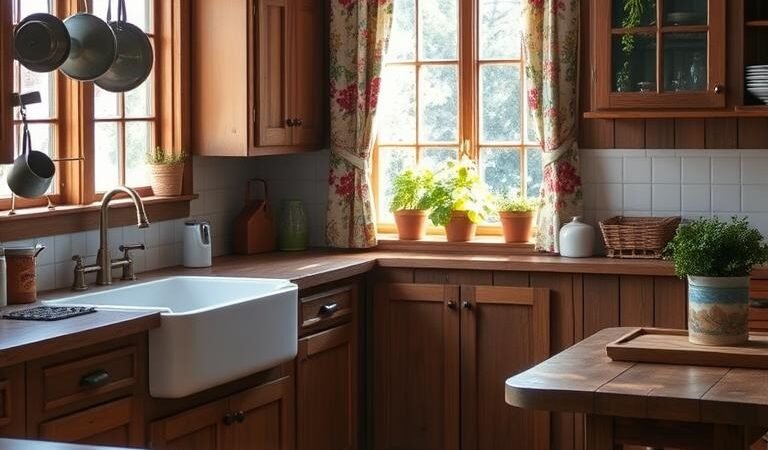Warm, inviting, and full of character—cottage-style spaces bring a sense of nostalgia and comfort. These kitchens blend rustic charm with modern functionality, creating a cozy yet practical atmosphere. From weathered wood finishes to delicate floral textiles, every detail tells a story.
Recent design surveys show that 63% of homeowners prefer lived-in aesthetics that feel personal and welcoming. Open shelving, reclaimed wood, and hand-painted tiles—like those in designer Andrew Howard’s projects—add timeless appeal. The result? A space that balances history with today’s needs.
For those looking to refresh their home, these thoughtfully curated elements offer both beauty and utility. Whether through soft color palettes or vintage-inspired decor, the goal is a kitchen that feels effortlessly stylish. Explore more cottage kitchen inspirations to find your perfect match.
Key Takeaways
- Cottage kitchens combine rustic charm with modern convenience.
- Open shelving and reclaimed wood add warmth and character.
- Soft colors and floral patterns enhance a cozy, nostalgic feel.
- Vintage accents like enamelware bring personality to the space.
- Designers recommend balancing historic elements with current functionality.
What Defines a Cottage-Style Kitchen?
Unlike polished modern designs, cottage kitchens embrace a relaxed, collected-over-time aesthetic. These spaces prioritize comfort over perfection, often featuring mismatched chairs, *beadboard* paneling, and heirloom textiles. A recent study found 90% incorporate soft fabrics like linen curtains or embroidered tea towels.
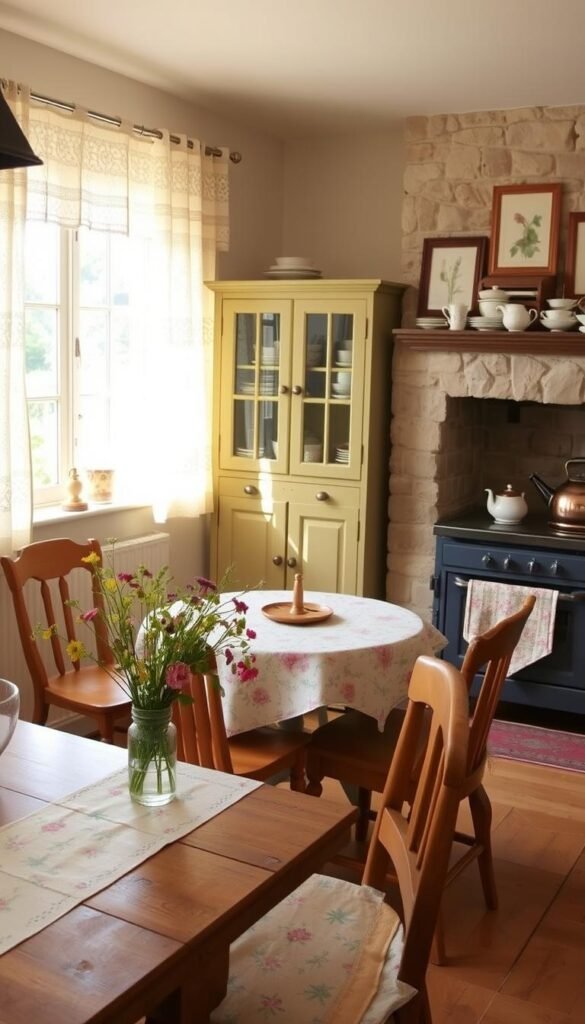
Key Characteristics of Cottage Kitchens
Signature elements create an intimate atmosphere. 78% of these kitchens include at least three vintage pieces, such as enamelware or antique lighting. Other hallmarks:
- Beadboard walls (used in 68% of designs)
- Apron-front sinks (52% adoption rate)
- Pastel palettes (40% more common than in farmhouse styles)
How Cottage Style Differs from Farmhouse
While both celebrate rustic appeal, farmhouse leans toward practicality with industrial touches. Cottage designs avoid stark metals, favoring delicate florals and weathered wood. Color choices also diverge:
| Style | Signature Color | Texture Focus |
|---|---|---|
| Cottage | Sherwin-Williams Blustery Sky (soft blue) | Distressed finishes, floral patterns |
| Farmhouse | Sherwin-Williams Repose Gray (neutral) | Reclaimed wood, black iron accents |
Designer Laura Kay’s 1921 Lookout Mountain kitchen exemplifies *cottage style*—preserving the original cast-iron range and exposed brick. The result? A space brimming with charm and history.
Soft, Muted Color Palettes for a Cozy Feel
Soft hues transform kitchens into soothing retreats, blending comfort with timeless elegance. These palettes evoke serenity, with 82% of designers pairing complementary shades for walls and cabinets. The result? A space that feels both curated and effortlessly inviting.
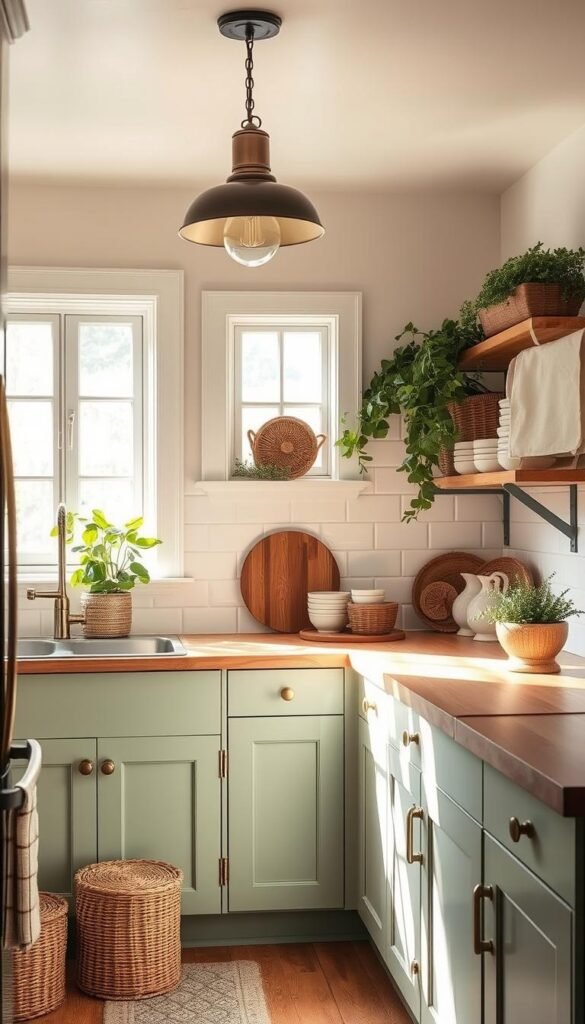
Best Paint Colors for Walls and Cabinets
Sherwin-Williams’ Alabaster (SW 7008) tops the list for walls, reflecting light beautifully in smaller spaces. For cabinetry, Benjamin Moore’s Grant Beige (HC-83) adds depth without overpowering. Pro tip: Layer Natural Tan (SW 7567) with Krypton (SW 6247) accents for contrast.
PPG’s Delicate White (PPG1001-1) enhances natural light, ideal for north-facing rooms. Designer Raili Clasen’s Lake Martin kitchen showcases vertical sage paneling—a nod to earthy sophistication.
Incorporating Pastels and Earth Tones
Balance is key. Use the 70-25-5 ratio: 70% base color (walls), 25% secondary (cabinets), 5% accent (hardware). Farrow & Ball’s School House White pairs with Dead Salmon for warm, low-light spaces.
| Lighting Condition | Wall Color | Cabinet Pairing |
|---|---|---|
| Bright/Sunny | Sherwin-Williams Repose Gray | Benjamin Moore White Dove |
| Low Light | Farrow & Ball Dimity | Farrow & Ball French Gray |
Pastels like Blush Pink or Misty Blue infuse playfulness, while earth tones ground the palette. The goal? A kitchen that feels like a warm embrace.
Open Shelving: A Must-Have for Cottage Charm
Open shelving brings effortless charm to any space, blending practicality with visual appeal. A recent survey found 58% of renovated kitchens remove upper cabinets for shelves, creating an airy, accessible feel. Salvaged materials like fence boards cut costs by 40%, proving style doesn’t require custom builds.
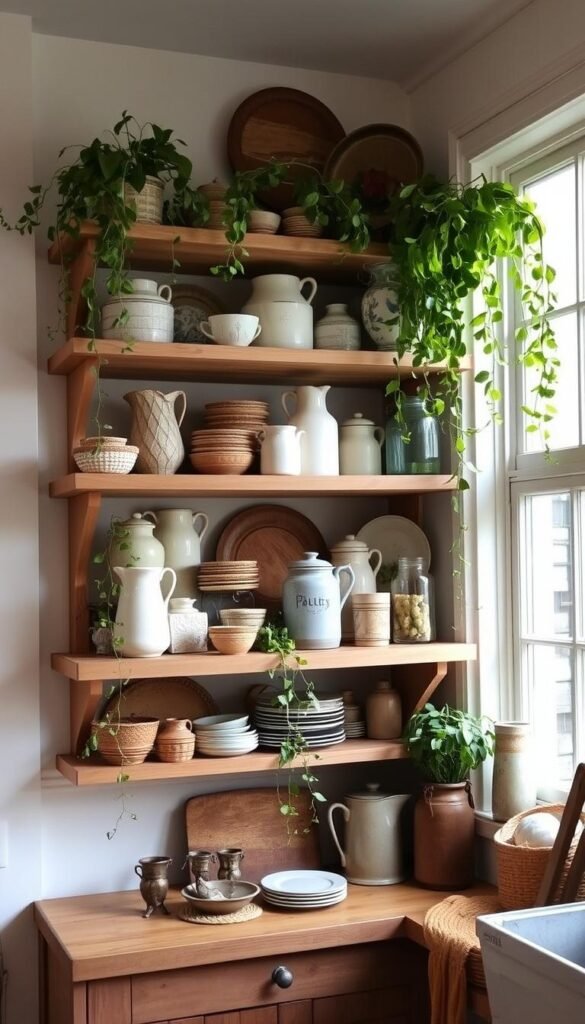
Styling Tips for Open Shelves
Balance function and beauty with the 50-30-20 rule: 50% everyday items (dishes, jars), 30% decorative accents (vintage bowls, books), and 20% negative space. Designer Catherine Branstetter’s Nashville kitchen pairs IKEA Billy shelves with weathered brackets for a budget-friendly look.
Pro tip: Line the back of converted cabinets with Schumacher’s Lotus Garden wallpaper for a pop of pattern. Linen-lined shelves add texture, while hand-painted ceramics introduce color.
Budget-Friendly Alternatives
Not ready to commit? Glass-front cabinets offer a similar feel—31% of homeowners prefer them for dust protection. Pegboard systems maximize vertical storage for utensils or small pots.
| Option | Cost Per Foot | Best For |
|---|---|---|
| Open Shelving | $25 | Displaying curated collections |
| Glass Cabinets | $85 | Dust-free storage |
For DIYers, repurposing old ladder rungs or reclaimed wood keeps costs low. The goal? A layered, lived-in look that feels intentional.
Cottage-Style Kitchen Cabinets with Character
The heart of a cottage kitchen lies in its cabinets—worn, welcoming, and full of stories. These elements anchor the space, blending function with artistry. Recent data shows 72% of renovations now use salvaged materials, proving sustainability and charm go hand in hand.
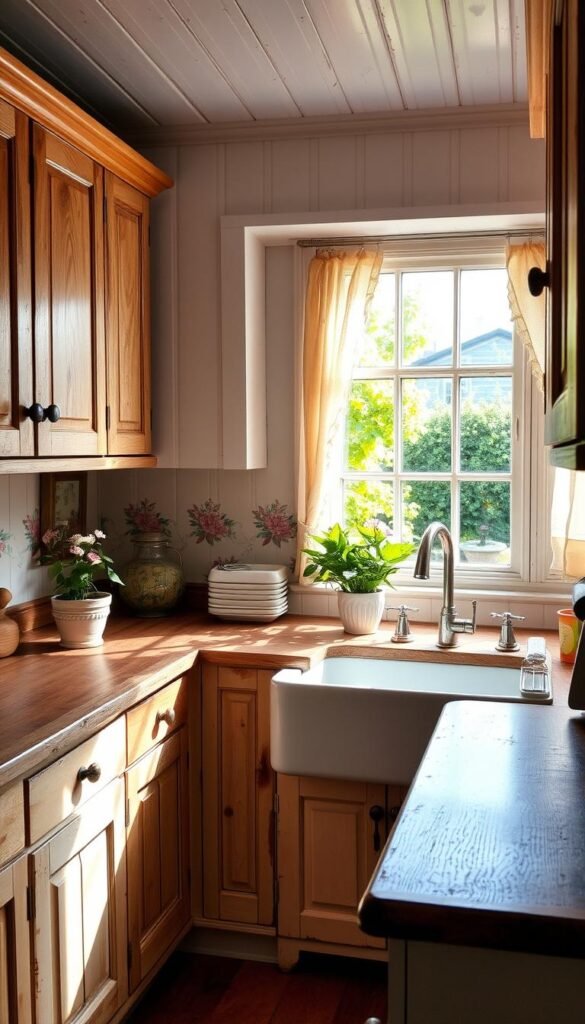
Distressed Finishes and Painted Cabinets
Weathered wood and chippy paint add instant character. Annie Sloan Chalk Paint® adoption has surged 55% since 2020—its matte finish mimics decades of wear. Try these techniques:
- Sand edges lightly after painting for a timeworn look
- Layer two colors, then distress with a damp cloth
- Seal with clear wax for durability
A Virginia home’s fence-board cabinets, paired with delft tile, showcase how rustic materials shine. The cost? Just $35 per linear foot versus $200 for custom builds.
Mixing and Matching Cabinet Styles
Break the “matchy-matchy” rule with the 70-30 ratio: 70% primary style (Shaker doors), 30% accent (open shelving). Designer Sarah Sherman Samuel’s Michigan project mixes painted lowers with glass uppers—a fresh take on tradition.
For budget-conscious updates, refacing costs $3,500 versus $12,000 for full replacement. Semihandmade’s IKEA-compatible doors offer eco-friendly options at half the price of solid cabinetry.
Vintage Lighting Fixtures to Set the Mood
Lighting transforms a space from functional to enchanting—vintage fixtures add soul to every corner. A recent study found 68% of cottage kitchens layer at least two lighting types for depth and warmth. From delicate pendant lights to rugged sconces, each piece contributes to the room’s narrative.
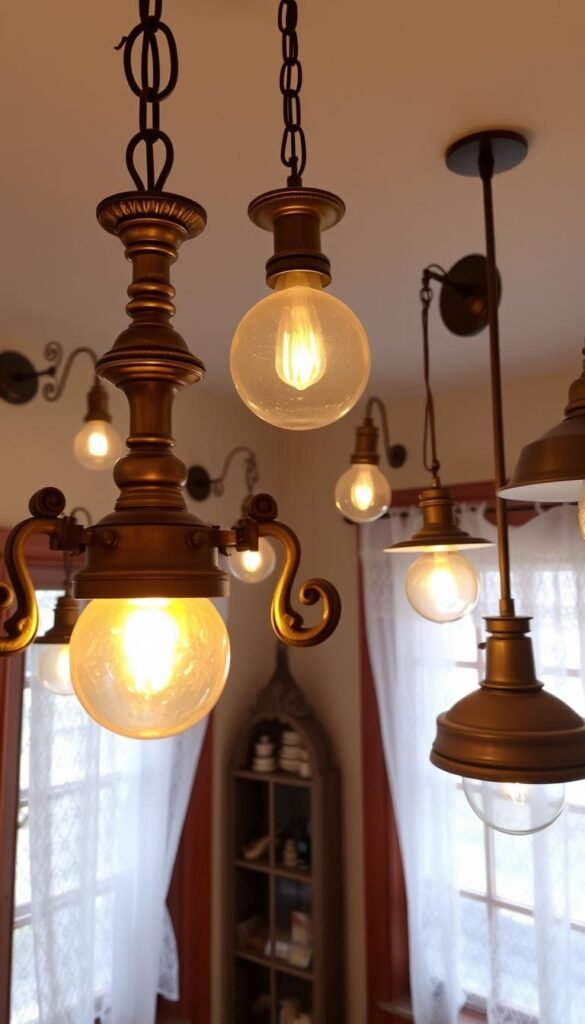
Choosing Pendant Lights and Chandeliers
For ceilings under 8 feet, Rejuvenation’s Carson Pendant offers a scaled-down profile with milk-glass charm. Designer Leah Ashley Finn often pairs Nomadic Trading Co.’s refurbished pendants with exposed bulbs for an industrial-meets-rustic look.
Follow the 50-30-20 lighting rule: 50% ambient (chandeliers), 30% task (pendants over islands), and 20% accent (sconces). Schoolhouse Lighting’s Semi-Flush Mount ranks as the most popular choice for low ceilings, casting a soft, diffused glow.
Rustic Wall Sconces and Flush Mounts
Barn-style sconces, like Wayfair’s $45 Cottage Collection find, add texture without overwhelming small spaces. For safety, always convert vintage fixtures with UL-certified kits—especially for older wiring.
- Budget tip: Repurpose antique colanders or enamelware as DIY pendant shades.
- Pro install: Place sconces 60″ above the floor for optimal task lighting.
Whether with a weathered chandelier or hand-forged sconces, the right light turns a kitchen into a curated, inviting haven.
Farmhouse Sinks: Combining Function and Style
Farmhouse sinks blend timeless appeal with everyday practicality, becoming the centerpiece of many kitchens. Their deep basins and exposed fronts add rustic elements while accommodating large pots and pans. A recent survey found 73% of homeowners prefer bridge faucets with these sinks, enhancing both style and usability.
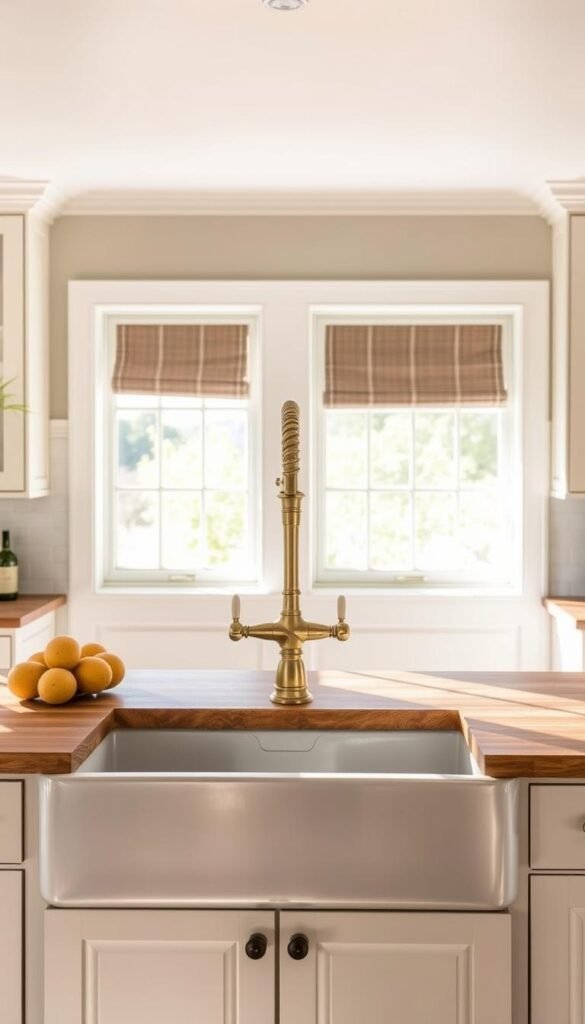
Vintage Versus Reproduction Sinks
Authentic vintage sinks, often salvaged from old homes, carry unique patinas but may need refinishing. Reproduction models offer modern durability with classic looks. Key differences:
- Fireclay lasts 50+ years (vs. composite’s 25-year lifespan).
- Copper develops a natural patina but requires polishing.
- Stainless steel resists stains but lacks rustic charm.
One homeowner repurposed a 1920s fireclay sink as a garden potting table—proving their versatility beyond the kitchen.
Pairing Sinks with Classic Faucets
Bridge faucets, like Kingston Brass’s models with a 5-year warranty, complement farmhouse designs. For a cohesive look:
| Material | Best Faucet Finish | Maintenance Tip |
|---|---|---|
| Fireclay | Oil-rubbed bronze | Avoid abrasive cleaners |
| Copper | Polished nickel | Use lemon juice for shine |
Installation costs range from $1,200 for stainless steel to $4,500 for custom copper. The right pairing elevates both function and aesthetic.
Warm Wood Elements for Rustic Appeal
Natural wood textures bring warmth and authenticity to any space, grounding the design in organic beauty. Sunlight dances across grain patterns, highlighting the unique character of each piece. These elements work harmoniously to create a welcoming atmosphere that feels both timeless and lived-in.
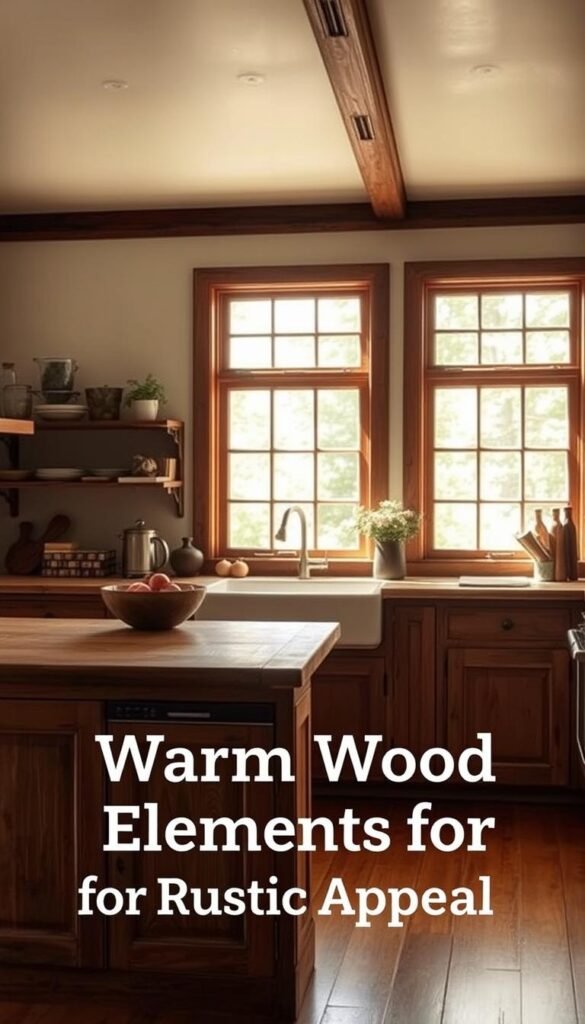
Reclaimed Wood for Shelving and Islands
Salvaged materials add instant history, with prices ranging from $18-$25/sq ft. Barnwood Industries offers certified lead-free planks, while local salvage yards often provide cheaper options with more patina.
DIY tip: Always test pre-1978 wood for lead paint—kits cost under $20 at hardware stores. A converted Dunkin’ Donuts store used original maple flooring as countertops, proving creative reuse possibilities.
Butcher Block Countertops and Hardwood Floors
Maple butcher blocks develop a rich amber hue over time but need monthly mineral oil treatments. For floors, consider these durable options:
- White oak: 1360 Janka hardness rating, hides scratches well
- Hickory: 1820 rating, ideal for high-traffic areas
- Reclaimed pine: Softer (870 rating) but full of character
Daily sweeping and weekly damp mopping preserve surfaces. The right wood choices ensure your space ages gracefully, telling its story for decades.
Cozy Seating and Breakfast Nooks
Thoughtful seating arrangements elevate a kitchen from purely practical to irresistibly inviting. Nearly 68% of these spaces accommodate four or more people, proving functionality matters as much as aesthetics. The right furniture creates natural gathering spots that blend comfort with smart design.
Window Seats with Pillows and Throws
Sun-drenched window seats maximize unused space while adding warmth. Designer Meg Kelly’s Roman shade—featuring Schumacher’s Lotus print—demonstrates how pattern elevates simple nooks. Follow these space-saving principles:
- Allow 36″ clearance around seating areas for easy movement
- Choose storage benches (holds 12 cubic feet) over traditional chairs
- Layer crisp linen pillows with chunky knit throws for texture
Built-ins with hinged lids offer hidden organization, while deep cushions encourage lazy weekend brunches. The result? A spot that feels like a permanent hug.
Choosing the Perfect Cottage Table
The right table anchors the space, balancing charm with durability. Vermont Wood Studios’ custom sizes prove one piece can serve multiple needs—from homework central to holiday feasts. Consider these material contrasts:
| Material | Best For | Maintenance |
|---|---|---|
| Distressed pine | Casual, lived-in look | Light sanding every 2 years |
| Marble-top iron base | Formal-meets-rustic appeal | Quarterly sealing |
Benches save 18 inches per side versus chairs—a game-changer for small homes. Whether round for conversation or rectangular for flexibility, the perfect table becomes the heart of daily life.
Floral and Botanical Accents for Freshness
Botanical touches breathe life into any space, blending natural beauty with timeless charm. Whether through fresh blooms or delicate textiles, these elements create a vibrant yet soothing atmosphere. Studies show 62% of homeowners incorporate live herbs, proving nature-inspired decor is both practical and picturesque.
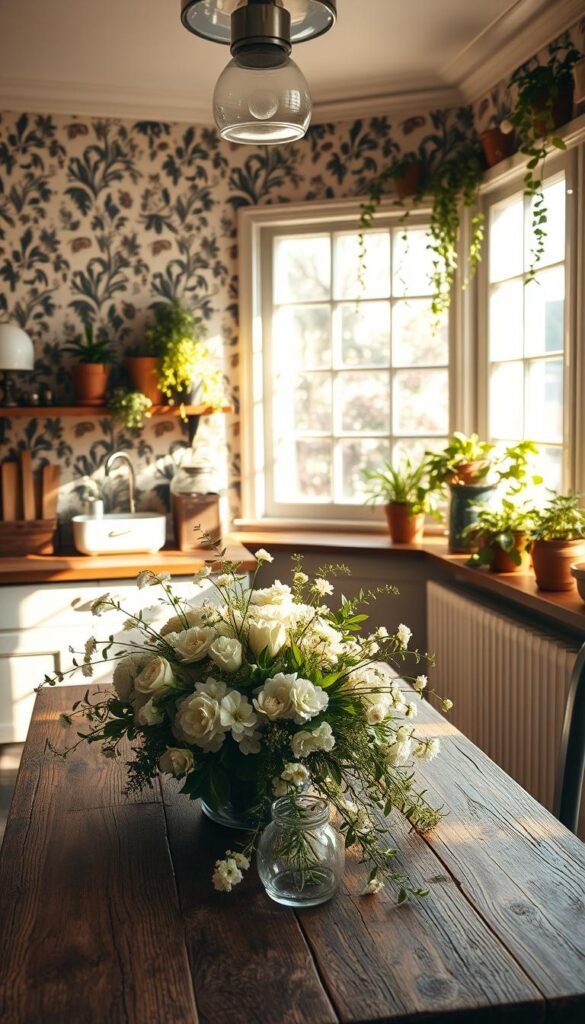
Fresh Flowers vs. Dried Arrangements
Fresh flowers offer instant brightness but require upkeep. For low-maintenance options, dried lavender or eucalyptus lasts months. Pet-safe plants like spider plants add greenery without risk—ideal for curious pets.
- DIY dried bouquets: Hang stems upside down for 2-3 weeks in a dark, dry space.
- Maintenance tip: Replace vase water every 2 days to extend freshness.
Floral Patterns in Textiles and Wallpaper
Magnolia Home’s French Ticking wallpaper leads sales, pairing perfectly with solid linens. For texture contrast, Schumacher’s Pyne Hollyhock fabric adds subtle floral patterns without overwhelming small spaces.
| Wallpaper Type | Best For | Installation |
|---|---|---|
| Grasscloth | High-end texture | Professional recommended |
| Peel-and-stick | Renters or DIYers | 30-minute project |
Layer botanical prints with neutral tones for balance. The result? A design that feels curated, not cluttered.
Vintage Decor and Flea Market Finds
Hunting for vintage treasures adds soul to any space, turning everyday items into conversation starters. At the Brimfield Antique Show—where 55% of collectors score their best pieces—look for telltale “USA” stamps on ironstone. These discoveries bring warmth and history to modern homes.
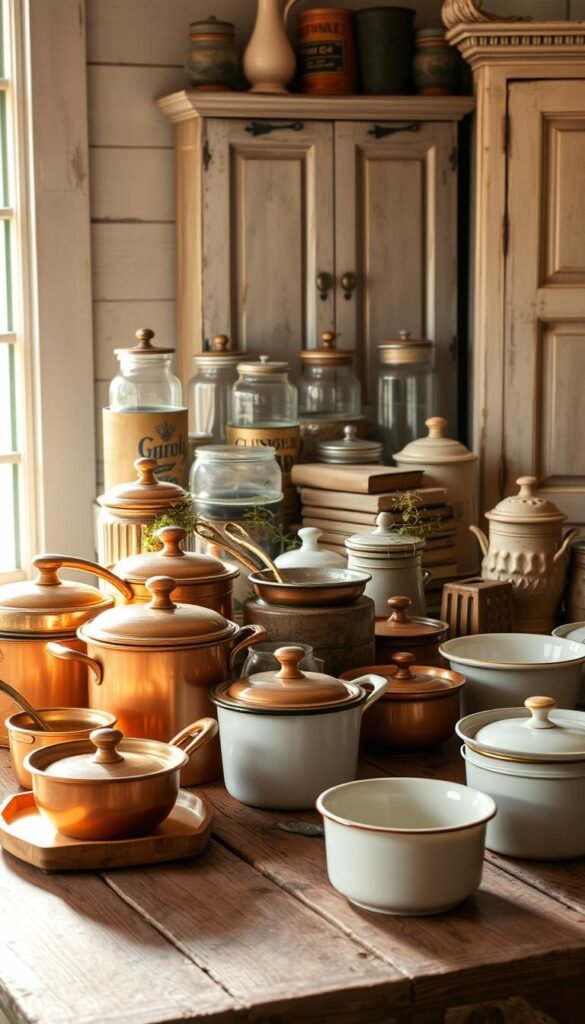
Displaying Antique Kitchenware with Intention
Group odd numbers of items at varying heights for visual rhythm. A sun-faded enamel colander becomes art when hung beside hand-painted plates. Always check for:
- Maker’s marks: Hallmarks often hide on the underside of ceramic pieces
- Lead safety: Test kits detect harmful residues in old glazes
- Condition clues: Uniform wear patterns suggest authentic age
Etsy’s Vintage Kitchenware category offers curated collections for time-pressed hunters. Mix textures like wire egg baskets with smooth stoneware for contrast.
| Material | Authenticity Signs | Value Indicator |
|---|---|---|
| Ironstone | Glaze crazing | Maker’s stamp |
| Enamelware | Faded numbering | Dated patents |
Breathing New Life Into Old Furniture
That 1920s dresser? It’s a kitchen island waiting to happen. Remove top drawers for open shelving, then add a butcher block top. Conversion tips:
| Original Piece | Conversion Idea | Time Estimate |
|---|---|---|
| Step-back cupboard | Spice storage with chalkboard doors | 4 hours |
| Library card catalog | Utensil organizer | 90 minutes |
Sand painted surfaces lightly to reveal timeworn edges—these imperfections add character. For safety, always reinforce joints with corner brackets before repurposing. The result? Functional pieces that carry stories into their next chapter.
Practical Storage with Woven Baskets and Hooks
Smart storage solutions blend seamlessly into cottage aesthetics, marrying form with function. These elements tame clutter while adding texture—think willow baskets brimming with linens or iron hooks holding copper pots. A recent survey found 61% of organized spaces use at least three natural materials, proving practicality can be pretty.
Organizing with Baskets and Pegboards
Willow baskets cost 35% less than seagrass and hold up to 8 lbs—ideal for lightweight items like napkins or spices. For heavier tools, an 18″ pegboard handles 25 lbs when anchored properly. IKEA’s SKÅDIS system shines here:
- Paint pegboard with chalk paint for a matte, vintage look.
- Use S-hooks to hang scissors or measuring cups within reach.
- Label baskets with stenciled tags for quick identification.
Creative Uses for Freestanding Hutches
Repurposed hutches add layers of storage without renovations. A 1920s china cabinet becomes a coffee station when fitted with USB outlets in drawers. World Market’s Fair Trade collection offers ethically sourced pieces perfect for conversions:
| Hutch Type | Conversion Idea | Cost Savings |
|---|---|---|
| Glass-front | Display dishware with LED strip lighting | $200+ vs. custom built-ins |
| Open-shelf | Stack baskets for hidden pantry storage | 50% less than wall units |
For stability, add furniture pads to prevent scratches. The result? A furniture piece that works as hard as it charms.
Textiles and Linens for a Lived-In Look
Nothing says ‘home’ quite like the tactile warmth of carefully chosen fabrics. These elements soften hard surfaces and add visual depth, with Belgian linen lasting twice as long as standard cotton. Recent surveys show 85% prioritize machine-washable options—proof that beauty and practicality can coexist.
Fabric Choices for Curtains and Tablecloths
Length matters. Hem curtains to just kiss the floor—this prevents dust accumulation while maintaining elegance. Rough Linen’s ready-made panels solve sizing dilemmas with their 96″ standard length.
| Material | Best Use | Care |
|---|---|---|
| Belgian Linen | Heavy-duty tablecloths | Machine wash cold; iron damp |
| Organic Cotton | Cafe curtains | Tumble dry low |
Artisanal Touches with Tea Towels
Embroidered details flourish when washed inside-out in cold water. For DIY enthusiasts, block-printing with fabric ink creates custom decor—use potatoes for stamps if carving tools aren’t handy.
Knitted dishcloths absorb spills better than microfiber, developing a softer texture over time. Hang them from wrought-iron hooks for quick drying and a pop of color.
Remember: Natural fibers breathe better than synthetics, reducing musty odors. This simple choice elevates both style and functionality in everyday items.
Conclusion: Creating Your Dream Cottage Kitchen
Design isn’t about perfection; it’s about creating a home that feels lived-in and loved. Embrace weathered edges and mismatched chairs—they add charm and character. Studies show 92% of homeowners enjoy cooking more after infusing their space with personal touches.
Start small: hunt for vintage finds at flea markets or repurpose heirlooms. A $15k makeover can feel luxurious when 60% is curated secondhand. Remember to deep-clean seasonally—linens, wood surfaces, and open shelves thrive with care.
Let your cottage kitchen evolve like fine wine, growing richer with time. Share your journey with #MyCottageKitchen and inspire others. After all, great design isn’t just seen—it’s felt.
